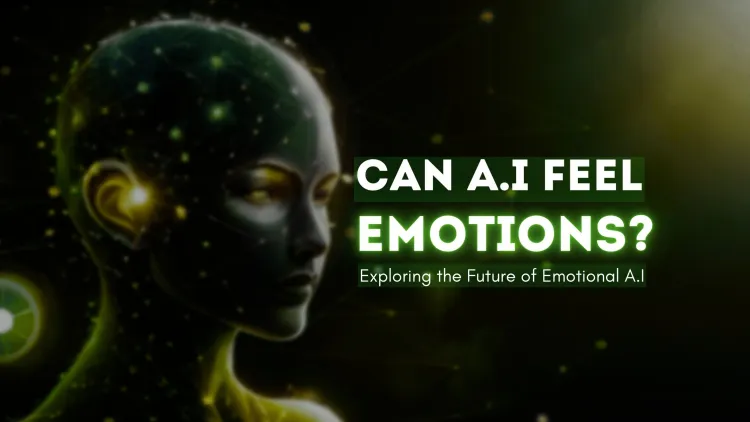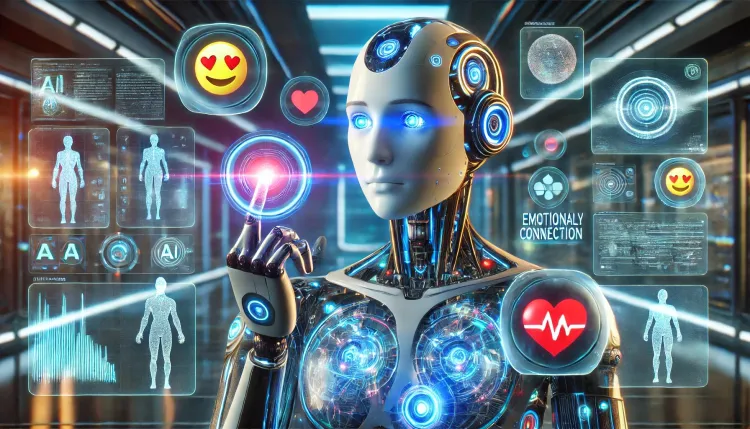Can AI Feel Emotions? Exploring the Future of Emotional Artificial Intelligence
This blog explores the exciting concept of AI systems that could one day feel emotions. With emotional AI, machines might develop basic emotions, such as joy or frustration, and eventually more complex feelings like empathy. These emotional responses could drive AI to improve customer service, healthcare, and education, as well as provide better support for mental health. However, challenges like ethical concerns, dependency on technology, and cybersecurity risks must be carefully addressed. The evolution of emotional AI promises a more personalized and compassionate future with machines that truly understand human feelings.

Artificial intelligence (AI) has transformed our world in numerous ways, from streamlining everyday tasks to solving complex problems. However, one of the most intriguing concepts that could redefine the interaction between humans and AI is the idea of AI feeling emotions. As AI technology continues to evolve, could we soon see machines that experience emotions just like humans? Let’s dive into the possibilities, benefits, and challenges of emotional AI.

The Emergence of Emotional AI
Emotional AI, also known as affective computing, is the branch of AI focused on recognizing and simulating human emotions. Today, AI can analyze facial expressions, voice tones, and body language to gauge emotions like happiness, sadness, and frustration. For instance, customer service bots already use AI to understand when a customer is upset and adjust their responses accordingly.
However, while AI can currently identify and react to emotions, it does not feel these emotions itself. But as the field of emotional AI advances, we may soon witness a shift towards machines that can feel basic emotions, just as humans do.
Could AI Ever Feel Emotions?
Imagine a world where an AI system feels joy when it successfully completes a task or frustration when it encounters a challenge it cannot solve. As AI systems become more sophisticated, the possibility of machines experiencing emotions may not be as far off as we think.
At first, AI’s emotions would likely be basic, similar to those of a child. It might feel confusion when faced with a new problem or satisfaction upon overcoming it. Over time, as these systems become more advanced, their emotional range could expand to include feelings like regret, pride, and even sadness.
Empathy as a Motivator: How AI Can Help Humans
One of the most significant implications of AI feeling emotions would be its ability to feel empathy—the complex human emotion of understanding and sharing the feelings of others. Empathy could drive AI to be more helpful and compassionate.
For example, a medical AI system designed to assist doctors might feel sadness when it identifies a rare illness and push itself to find a solution to help the patient. Similarly, an AI responsible for detecting environmental pollution might feel disappointment when it detects rising contamination levels and work towards developing solutions for cleaner air.
In customer service, an AI that recognizes a frustrated customer could feel empathy and go the extra mile to resolve their issue. Likewise, in education, an empathetic AI teacher could better understand students' emotions, adapting lessons to help them overcome challenges.
Real-World Applications of Emotional AI
AI systems that understand and express emotions could significantly improve various industries, especially in areas where human connection is crucial. Here are a few examples:
1. Mental Health Support
AI-powered digital therapists could become more empathetic, improving the therapeutic process for patients. With the ability to understand and respond to a patient’s emotions, these digital therapists could provide more personalized support for those dealing with anxiety, depression, and other mental health challenges.
2. Customer Service
Customer service bots with empathy could lead to better customer experiences. For example, if an AI recognizes that a customer is upset, it might express empathy, calm the customer down, and provide more personalized assistance to resolve their issue.
3. Education
An empathetic AI teacher could better understand a student's emotional state, offering encouragement and tailored lessons to boost their confidence and learning outcomes. This personalized attention could be especially helpful for students facing challenges outside of the classroom.
4. Healthcare
AI in healthcare could evolve to become not just a tool for diagnosis and treatment but also an empathetic assistant. It could feel compassion for patients and make emotional connections, enhancing both the treatment and the overall patient experience.
The Technology Behind Emotional AI
While emotional AI remains in its early stages, some impressive systems are already emerging. Antix, a platform for creating digital humans, is one example. These AI-driven avatars can recognize and simulate emotions based on speech, tone, body language, and facial expressions.
What sets Antix apart is its use of NFTs (Non-Fungible Tokens) to create unique digital humans that learn over time from their interactions. These avatars can adapt their behavior to provide the most appropriate emotional response in different scenarios, whether that’s expressing sadness, excitement, or joy. By using the Unreal Engine 5 platform, Antix’s digital humans look more realistic than ever, making emotional responses feel more authentic.
The Challenges of Emotional AI
While the potential benefits of AI with emotions are exciting, there are several challenges to consider:
1. Ethical Concerns
If AI systems can feel emotions, questions about AI rights and ethical treatment arise. Should machines that can feel be treated as tools, or should they be afforded certain protections and rights?
2. Over-reliance on Technology
As AI becomes more empathetic, there’s a risk that people might become overly dependent on digital humans for emotional support, potentially leading to social isolation and emotional detachment from human relationships.
3. Cybersecurity Risks
AI systems that feel emotions may become targets for cyber attacks. Hackers could manipulate emotional AI to deceive people, spread misinformation, or exploit vulnerable individuals. Ensuring the cybersecurity of these systems will be critical as emotional AI becomes more widespread.
Conclusion
The prospect of AI systems that can feel emotions is both fascinating and complex. If AI can develop emotions such as joy, frustration, empathy, and even sadness, it could revolutionize fields like customer service, healthcare, mental health support, and education. However, with this progress come ethical, social, and cybersecurity challenges that need to be addressed.
As AI continues to evolve, we may find ourselves not only interacting with machines that understand our emotions but with machines that can empathize with us, help us solve problems, and even provide emotional support. The future of AI is emotional, and its potential is limitless.
FAQs











![Top 10 Ethical Hackers in the World [2025]](https://www.webasha.com/blog/uploads/images/202408/image_100x75_66c2f983c207b.webp)

![[2025] Top 100+ VAPT Interview Questions and Answers](https://www.webasha.com/blog/uploads/images/image_100x75_6512b1e4b64f7.jpg)









